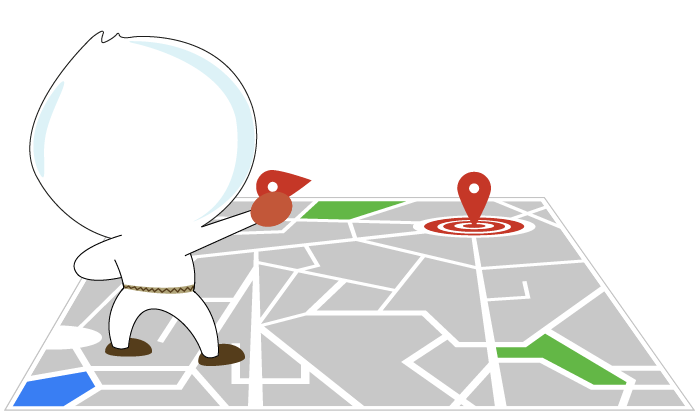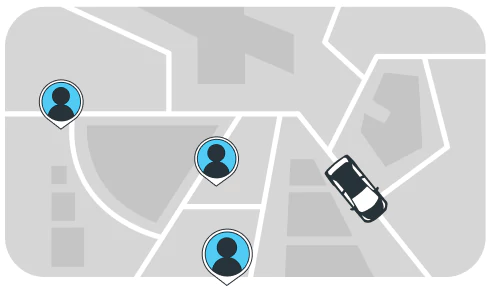It takes a good SEO strategy to highlight a website’s best features. Optimisation is a never-ending task that needs to keep up with Google’s quest for relevant search results. Google’s latest interface also reflects this mindset. Google My Business was released in 2014 and has been revolutionising local SEO ever since.

What is Google My Business, exactly, and how can you take advantage of it?
With Google My Business: be visible in your geographical area
A company’s visibility is even more important within its direct vicinity, in the towns or regions where it offers its services. Naturally, you will want to get the best Google SEO possible and target the best areas for your business. The idea is to reach potential customers where and when they happened to be looking for your product or service on Google.
To that end, optimisation experts work on 4 types of results provided by Google:
- Organic results: the highest-ranking websites for a given web query in terms of keywords.
- Google+ local results: the websites associated with Google Maps and based on your geographical location.
- Local organic results: the best websites for a search query based on your geographical location.
- Sponsored links: AdWords – paid – adverts, which can also be local campaigns.
A business’s geolocation is of the essence when it comes to developing their activity. As many as 46% of people who search Google perform local queries, and half of travel or restaurant-related searches lead to a reservation or booking. (Source: Chatmeter)
Local SEO: before and after Google My Business
BEFORE GOOGLE MY BUSINESS
Before the launch of Google My Business, businesses used to handle local SEO through a page:
- Google Addresses to provide the search engine with the client’s Google Maps information all while working on the local organic results.
- Google+ local to collect ratings, pictures, create posts, and provide useful, practical information.
In addition, they would write dedicated content to improve the pages’ rankings for very specific locations.

SINCE GOOGLE MY BUSINESS
As of June 2014, Google My Business has been bringing together the functionalities of Google Addresses and Google + local under a single interface. On its home page, the American giant sums up the usefulness of this tool perfectly and succinctly:
“Stand out on Google with a free business profile. Turn people who find you on Google Search and Maps into news customers with a free Business Profile for your storefront or service area. Personalise your profile with photos, offers, posts, and more.”
What is Google My Business? A decidedly relevant tool for any small business whose customers’ interests all revolve around the same passion. For instance, vintage cars, Chinese cuisine, impressionist painting, etc.
Google My Business: the vital tool for local businesses
COMPREHENSIVE FUNCTIONALITIES ALL UNDER ONE INTERFACE
The interface Google has been offering since June 2014 allows SMEs to make themselves known to their customers and to interact with them, all while taking advantage of interesting statistical data:
- Informative aspect: business information updates, pictures of the building and/or a virtual tour of the facility…
- Social aspect: establishing a relationship with fans and customers through the Google+ page, information sharing (events, news, product launches, etc.), access to ratings/comments posted on the web, and the ability to respond to reviews.
- Statistical aspect: queries performed by Internet users to find your business, data about the information they searched for, etc.
Note that a Google My Business app is also available on Android and iOS smartphones and tablets. This is relevant because 88% of searches for local businesses on a mobile device either lead to a phone call or a visit within the next 24 hours. (Source: Hubpost.)
5 reasons to adopt Google My Business
Google is constantly improving its tools to help SEO professionals. While they are indeed innovative, these are not always relevant. This is not the case when it comes to Google My Business, however. If used properly, it offers:

- Increased visibility on the search engine, making your space more visually compelling and interactive to attract Internet users to your business rather than to the competition.
- A beautiful and responsive page: the multiplication of media that we are seeing today means the websites need to adapt to all the different formats (responsive design). If it’s not yet the case, users can be directed to the Google My Business page, which offers a streamlined experience.
- First-page visibility: with Google My Business, you can appear above the floating line, and thus increase traffic from your page and Google Maps presence.
- Potential benefits for search engine optimisation: although we may not have all the hindsight necessary to make definitive claims on this, there is no doubt that a well-optimised page offers visibility, traffic, and possibly conversions.
Still to come, “Local Search” experts are mentioning the concept of “Placerank”, which could become one of the criteria given to the most relevant Google My Business pages (high added value, rich content, access to services, etc.).
- Special offer coupons to be used on Google AdWords are beneficial from a marketing standpoint.
Google My Business: Powerful and easy to use
Google is a powerful search engine which meets every single need, voiced out or not. A simple query such as “hairdresser” gives you the first results within your immediate geographical location: this means results can be contextualised…
It only remains to optimise the results by promoting a local business to the customer over any others. Beyond a high-quality corporate website, it also means subscribing to Google My Business, the new toolbox designed for SMEs.
Note that while Google My Business involves creating a Google+ business account, having a website is not required, even though it undoubtedly strengthens any online strategy.
A simple implementation
In practical terms, to create a Google My Business page, you just need to follow these steps:
- Go on the Google My Business website
- Click the blue button “Register my business on Google”
- Once you are on Google Maps, search for the business by entering its name and address in the top right area. Or you could select the option “I have entered the name and address – Let me type in all the information related to my business”.
- Create an account or connect to your Google+ page
- Click “Continue” once you have ticked the box “I am authorised to manage this business and I accept the terms of use”.
- Account validation step, which you can take care of later by clicking “Continue and Validate later”.
- Fill out the Google+ and Google My Business profiles – and any other forms – as accurately as possible: opening and closing times, phone number, website, postal address, email address, etc.
This will improve your rankings among local results as well as on Google Maps. You can then optimise further by adding ratings from satisfied customers.

A boost for your local SEO
OPTIMISE YOUR LOCAL SEO EFFECTIVELY
It is essential to set up Google My Business and use this fantastic tool correctly, and you should not forget to improve your local SEO through traditional means:
- Mention the location(s) in your pages’ tags and titles
- Use the microdata format (preferably!) to optimise the description of the information you provide. This means integrating geolocation properties to indicate the place’s latitude and longitude: Google Help.
- Being referenced on high-quality local directories
- The website’s local image through its connection with local partners (links)
And let’s not forget about the obvious factors that are producing quality content on a regular basis, generating high-quality links, and making sure the website and the business’s technical optimisation is flawless.
THROUGH YOUR ADWORDS ACCOUNT, KEEP LOCATION EXTENSIONS
Local Google My Business SEO may be coupled with Google AdWords campaigns to attract more Internet users located or looking for results nearby. On average, campaigns that use location extensions boast a 10% higher click-through rate on average. (Source: Google)
Until the 18th of August 2014, location extensions – meaning the business addresses associated with AdWords campaigns – were written manually. This manoeuvre, which disappeared on that date, is now handled automatically via Google My Business.
Yet, it is still possible to enjoy the benefits of the location extension and to boost your local SEO by including it into your AdWords campaigns. To do so, just follow these steps:
- Sign into your AdWords account or register your business on Google AdWords.
- Click on “Ad Extensions”
- Select “Display: Location Extensions” which appears in the drop-down menu above the table
- Select “Updates” in the drop-down menu next to it
- Click on “+Extension” to connect your account to your Google My Business page.
You can now assign one or more addresses to your campaigns or groups of ads by using filters. Note that you can control how they perform on your AdWords account through a statistics table.
Conclusion
Google My Business SEO has become a staple strategy to improve your relevance. This tool is well suited to businesses with a local customer base, such as restaurants or hairdressers for instance. On the other hand, given that its main strength is geolocation, it might be worth wondering if it might restrict a company’s reach should they want to move onto a wider market.
Let’s take a search optimisation agency based in Paris as an example. Would it truly be good for them to connect their activity to Google My Business given that they offer their services nationwide? Would it make more sense to get a higher ranking in Paris if it means missing out on global SEO?
Are you a neighbourhood business?












